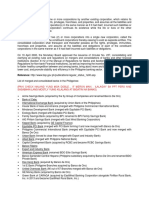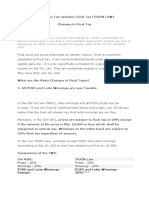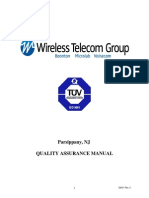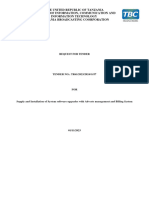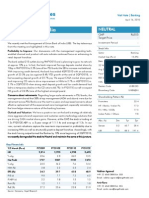Good - Governance Reviewer
Good - Governance Reviewer
Uploaded by
Romel BalinCopyright:
Available Formats
Good - Governance Reviewer
Good - Governance Reviewer
Uploaded by
Romel BalinOriginal Title
Copyright
Available Formats
Share this document
Did you find this document useful?
Is this content inappropriate?
Copyright:
Available Formats
Good - Governance Reviewer
Good - Governance Reviewer
Uploaded by
Romel BalinCopyright:
Available Formats
GOOD GOVERNANCE AND SOCIAL RESPONSIBILITY DEFINITION OF GOOD GOVERNANCE Governance refers to the process of decision making and
the process by which decisions are implemented. The term governance can be applied to corporate, international, national, local governance of the interaction between other sectors of society. DEFINITION OF SOCIAL RESPONSIBILITY It is an obligation to act in a manner that will benefit the society at large. CORPORATE GOVERNANCE A system by which business corporations are directed and controlled. (according to OECD Organization for Economic Cooperation Development) OECD PRINCIPLES OF CORPORATE GOVERNANCE COVERS 5 AREAS: 1. Ensuring the basis for an effective corporate governance framework The corporate governance should be effective, transparent and in accordance with the rule of law, clearly defining the responsibilities among different supervisory, regulatory and enforcement authorities. 2. Rights of shareholders 3. The equitable treatment of shareholders Equal treatment for all shareholders, including minority and foreign shareholders. All shareholders should have the opportunity to obtain effective redress for violation of their rights. 4. The role of stakeholders in corporate governance The corporate governance framework should recognize the rights of stakeholders of the corporation and encourage active co-operation in creating wealth, jobs and sustainability of a financially sound enterprises.
Stakeholders of a corporation/MNEs 1. employees 2. creditors 3. suppliers 4. customers 5. government 5. Disclosure and Transparency The corporate governance framework should ensure that timely and accurate disclosure should be made on all materials matters regarding the corporation, including the financial statements, performance, ownership and governance of the company. RELATIONSHIP OF CORPORATIONS AND STAKEHOLDERS 6. The Responsibilities of the Board Corporate governance framework should ensure the strategic of the company, the monitoring of management by the board and the boards accountability to the company and the shareholders. CORPORATE GOVERNANCE STRUCTURES 1. The Board of Directors 2. Officers and Management 3. Equity Markets 4. Debt Markets 5. Auditors and Legal Advisors 6. Regulators MULTINATIONAL CORPORATION - is an enterprise that manages production and delivers goods in more than one country. - any corporation that is registered and operating simultaneously in more than one country, usually with its headquarters in a single country.
DIFFERENCES BETWEEN MNCs and DOMESTIC FIRMS 1. MNCs have to deal with more demanding and more diverse global shareholders who want to seek greater disclosure and more transparent explanations for major decisions. 2. Domestic firms have only one board and one executive team MNCs have several boards or executive teams at different level. 3. MNCs face various corporate governance standards institutionalized by different countries in which they invest and operate. COMPARATIVE CORPORATE GOVERNANCE REGIME REGIME BASIS/ CHARACTERISTICS MARKET BASED Efficient equity market; dispersed ownership FAMILY BASED Management and ownership is combined; majority and minority shareholders
EXAMPLES United States, United Kingdom, Canada, Australia Hong Kong, Indonesia, Malaysia, Singapore, Taiwan, France
REGIME BASIS/CHARACTERISTICS BANK BASED Government influence in bank lending; lack of transparency; family owned GOVERNMENT AFFILIATED State ownership of enterprise; lack of transparency; no minority influence EXAMPLES Korea, Germany, China, Russia PARENT SUBSIDIARY CORPORATE GOVERNANCE IN MNCs Parent Level or 1st tier governance influences 2nd tier through: - Ownership holding - Organizational coordination - Corporate support - Performance Monitoring Subsidiary or 2nd tier governance in turn channels back to 1st tier corporate governance through : - Advice provision - Governance sharing - Information reporting - Directorate expansion Link between parent and subsidiary is generally manifested in ownership participation where in the parent board is often has the utmost and final authority to approve large investment overseas, whether joint ventures or acquisition Linked through information sharing. For instance, subsidiary board may inform parent board of behaviours of subsidiary executives and may advise parent board how to improve ethical behaviors of overseas employees. Hence, subsidiary board and the parent board , to some extent shares an MNCs total corporate governance with parent board.
Linked through information reporting and feedback. If parent board wants to know how corporate executives are doing with respect to ethical behaviors and global leadership, the subsidiary managers are the perfect channel to get information and feedback for parent board. Subsidiary board advising agent of parent or 1st tier such as changes and development of the host country. In turn parent board may advice subsidiary board of the activities in the MNCs so that the latter know better about MNCs overall global strategy. WHY CORPORATE GOVERNANCE VARIES AMONG NATIONS? CULTURE LEGAL POLITICAL SYSTEM CATEGORY OF CORPORATE GOVERNANCE INSIDER DOMINATED Companies are owned and controlled by a small number of major shareholders.These maybe members of the founding families or small group of shareholders such as lending banks or the government. Also referred to as relationship based systems because of the closed relationship prevalent between the companies and their dominant shareholders OUTSIDER DOMINATED SYSTEM Refers to the systems of finance and corporate governance where most large firms are controlled by their managers but owned by outside shareholders such as financial institutions or individual shareholders. ANGLO SAXON SYSTEM Focuses on the separation of ownership from control Characterized by unitary or one board that consists of directors in top management positions in the company and outside directors who are not company employees Directors with management positions are usually referred to as insiders or executive directors Directors not members of the management are known as non-executive or outside directors Anglo Saxon views corporation as a nexus of contract
Some deficiencies of the Anglo Saxon System Board duality wherein CEOs are also board chairman is common. Insider trading are still frequent Corporate transparency is not always present Outsider directors and auditors are not always independent nor professionally or ethically competent CORPORATE GOVERNANCE IN CONTINENTAL EUROPE Most corporate governance in Continental Europe (mainly Germany, Austria, Italy and Netherlands and to some extent France) have adopted a 2-tier board. Two tier board comprises the supervisory and the management boards Corporate governance of Anglo Saxon Countries and Continental Europe Anglo Saxon Ownership Concentration -Low ownership concentration Shareholder Identity - US and UK, most of the shares are in the hands of agents of financial institution rather than private persons. Liquidity of the Market - Many companies are listed and publicly traded. This means many companies have little personal contact with their shareholders.
Mutual Shareholdings Presence of anti-trust law and arms length rule between parent and daughter companies have limited ownership structure. Ownership structure is transparent
Continental Europe Ownership Concentration - high ownership concentration Shareholder Identity Sharp contrast with Germany, France and Italy where private companies, financial institutions and private persons hold most of the shares. Private persons and companies act directly and do not use agents to manage their affairs. Liquidity of the Market - Fewer companies are publicly traded. Because more companies are private, there exists strong (personal) relationship between company and its shareholders. In most cases, these two functions are not separated. Mutual Shareholdings Companies hold large stakes in other companies (related) and shareholdings also moves in the opposite direction Ownership structure is not transparent due to the no. of mutual shareholdings and limited extent of information disclosure. Corporate Governance in US Corporate governance of US was patterned under the Anglo Saxon System It is an Outsider Dominated System Category of corporate governance. Several scandals happened in US for the past years, some of which are: ENRON scandal - Enron is an energy company collapse in 2001 due to allegations of accounting fraud. Worldcom - a telecommunications company - fraud activities began in 1999 to 2002 - use shady accounting methods to mark its declining financial condition by falsely declaring a financial growth and profitability to increase the Worldcoms price of stocks.
Sarbanes Oxley Act of 2002 (SOX) - a US federal law enacted on July 30, 2002 which set new or enhanced standard for all US public company board, management and accounting firms - The bill was enacted as a reaction to a number of major corporate accounting scandals in US. Sponsors of SOX 1. 2. US Senator Paul Sarbanes US Representative Michael G. Oxley
Corporate governance in Japan Characterized by a long term, cooperative relationships among managers, major shareholders and business partners Japanese corporate governance is largely characterized by the keiretsu system and the main bank system Keiretsu Member companies owned small portions of the share in each others companies, centered on a core bank This system helps protect the company managements from stock market fluctuations and takeover attempts.
Main Bank System Banks is often one of the largest shareholders in a Japanese firm. Japanese firms enjoyed less pressure from the capital market due to: 1. intermediate finance via banks 2. stable shareholding among a group of firms 3. interlocking directorate practices
Family Centered Corporate Governance in Asia Family centered relationship model in corporate governance is even more evident in countries or regions where ethnic Chinese play a dominant role in local economies Insider Dominated is the system category of corporate governance in Family centered countries in Asia. Transition economy - an economy that is changing from centrally planned economy to a free market - decisions on investment and production are formulated by a central authority, usually a government agency. Corporate Governance in Transition Economies Corporate governance in transition economies is relatively weak because of: 1. lack of transparency 2. limited protection of property rights 3. underdeveloped institutions (e.g. independent auditing, accounting law, arbitration services) 4. poor enforcement of laws, rules and verdicts 5. lack of independence in banks loan decisions 6. distorted stock market
You might also like
- Episodic Mindware Template 1Document1 pageEpisodic Mindware Template 1delumennikkaNo ratings yet
- Handling Guest ComplaintDocument7 pagesHandling Guest ComplaintCheline nera100% (4)
- Section 73. Books To Be Kept Stock Transfer AgentDocument5 pagesSection 73. Books To Be Kept Stock Transfer AgentIan Joshua Romasanta100% (1)
- Distinction Between Partnership and CorporationDocument2 pagesDistinction Between Partnership and Corporationdyajee198682% (11)
- MergerDocument6 pagesMergerAyrah Erica Jaime100% (1)
- Financial Strategy in RetailDocument22 pagesFinancial Strategy in RetailGaurav KumarNo ratings yet
- Midterms Case Study Week 8Document3 pagesMidterms Case Study Week 8Dimple Mae CarilloNo ratings yet
- Notes To TITLE III (Sections 22-27) Corporation CodeDocument7 pagesNotes To TITLE III (Sections 22-27) Corporation Codehannabee00No ratings yet
- LAW Section 59-72Document15 pagesLAW Section 59-72Poison IvyNo ratings yet
- Pre-Discussion Questions and Critical Thinking TicklersDocument3 pagesPre-Discussion Questions and Critical Thinking TicklersRonna Mae DungogNo ratings yet
- A Partnership With A Capital Less Than 3000 Is Void If It Is Unregistered With SECDocument4 pagesA Partnership With A Capital Less Than 3000 Is Void If It Is Unregistered With SECElla Mae TuratoNo ratings yet
- Handouts Gross EstateDocument2 pagesHandouts Gross Estateonlineonrandomdays100% (1)
- Introduction To Audit Services and Financial Statements AuditDocument35 pagesIntroduction To Audit Services and Financial Statements AuditBryzan Dela CruzNo ratings yet
- IA2 06 - Handout - 1 PDFDocument5 pagesIA2 06 - Handout - 1 PDFMelchie RepospoloNo ratings yet
- Chapter 3 - The Revised Chart of AccountsDocument3 pagesChapter 3 - The Revised Chart of AccountsMarion LeocarioNo ratings yet
- BuyGasCo Legal Team AssessmentDocument3 pagesBuyGasCo Legal Team AssessmentLeslie RondinaNo ratings yet
- References: Philippine Tax Code CREATE Law TRAIN Law Income Taxation, Banggawan RR8-2018 RR14-2001Document13 pagesReferences: Philippine Tax Code CREATE Law TRAIN Law Income Taxation, Banggawan RR8-2018 RR14-2001Mark Lawrence YusiNo ratings yet
- FINMARDocument1 pageFINMARelaineNo ratings yet
- TITLE VI MeetingsDocument14 pagesTITLE VI Meetingsjomari legaspi0% (1)
- Principles of TaxationDocument32 pagesPrinciples of TaxationTyra Joyce Revadavia100% (1)
- Ethical Aspects in Tax AdministrationDocument18 pagesEthical Aspects in Tax AdministrationsandipgargNo ratings yet
- Hbo Chapter 1Document8 pagesHbo Chapter 1dar •No ratings yet
- Prelim Topics BM 2Document32 pagesPrelim Topics BM 2ME ValleserNo ratings yet
- DIRECTORS, TRUSTEES & OFFICERS (Sec.22-34)Document14 pagesDIRECTORS, TRUSTEES & OFFICERS (Sec.22-34)School FilesNo ratings yet
- Accomplishment Report 1ST Sem Ay 16 17Document5 pagesAccomplishment Report 1ST Sem Ay 16 17JPIA MSU-IITNo ratings yet
- History With PicturesDocument10 pagesHistory With PicturesBaylon Rachel100% (1)
- Classification of Contracts According To Importance or Dependence of One Upon AnotherDocument2 pagesClassification of Contracts According To Importance or Dependence of One Upon AnotherOliverMastileroNo ratings yet
- How Defective Contracts Are ClassifiedDocument2 pagesHow Defective Contracts Are Classifiedaccounts 3 lifeNo ratings yet
- De Leon, Bianca MhaeDocument7 pagesDe Leon, Bianca MhaeBianca Mhae De LeonNo ratings yet
- Chapter 13-Leases: Leases - An Agreement Whereby The Lessor Conveys To The Lessee, in Return For A Payment or Series ofDocument5 pagesChapter 13-Leases: Leases - An Agreement Whereby The Lessor Conveys To The Lessee, in Return For A Payment or Series ofShantalNo ratings yet
- PFRS of SME and SE - Concept MapDocument1 pagePFRS of SME and SE - Concept MapRey OñateNo ratings yet
- Lesson 3 - Fundamentals of Income Taxation PDFDocument9 pagesLesson 3 - Fundamentals of Income Taxation PDFErika ApitaNo ratings yet
- Title 5 6Document4 pagesTitle 5 6Dimple Mae CarilloNo ratings yet
- An Examination of Factors Affecting The Passing Rates of The CPA ExaminationDocument20 pagesAn Examination of Factors Affecting The Passing Rates of The CPA ExaminationKimberly BanuelosNo ratings yet
- Define Business Combination, Identify Its ElementsDocument4 pagesDefine Business Combination, Identify Its ElementsAljenika Moncada GupiteoNo ratings yet
- Article 1771Document1 pageArticle 1771karl doceoNo ratings yet
- Republic Act No. 3591 Philippine Deposit Insurance CorporationDocument42 pagesRepublic Act No. 3591 Philippine Deposit Insurance CorporationJomer FernandezNo ratings yet
- Article 1597 1601Document3 pagesArticle 1597 1601Justin Miguel Apostol SaludezNo ratings yet
- Corporate Governance, Business Ethics, Risk Management and Internal ControlDocument43 pagesCorporate Governance, Business Ethics, Risk Management and Internal ControlRohanne Garcia AbrigoNo ratings yet
- Special Itemized Deductions, NOLCO & OSDDocument13 pagesSpecial Itemized Deductions, NOLCO & OSDdianne caballero100% (1)
- (Group 2) Cearts 1 - Philippine Popular CultureDocument3 pages(Group 2) Cearts 1 - Philippine Popular Culturerandom aestheticNo ratings yet
- Meetings of Directors or Trustees, Stockholders orDocument9 pagesMeetings of Directors or Trustees, Stockholders orAmie Jane MirandaNo ratings yet
- Accounting in IT - Final ExamDocument8 pagesAccounting in IT - Final ExamIce coldNo ratings yet
- Interest Rates and Security ValuationDocument50 pagesInterest Rates and Security ValuationBrithney ButalidNo ratings yet
- Income Taxation Reviewer Banggawan 2021Document13 pagesIncome Taxation Reviewer Banggawan 2021Merwelyn FradesNo ratings yet
- PseDocument10 pagesPseDarlene Joyce GarciaNo ratings yet
- Discussion QuestionsDocument4 pagesDiscussion Questionsfahad BataviaNo ratings yet
- True or FalseDocument7 pagesTrue or False이삐야No ratings yet
- Philippine Deposit Insurance Corporation (PDIC) LawDocument11 pagesPhilippine Deposit Insurance Corporation (PDIC) LawElmer JuanNo ratings yet
- Module 2 - Income Taxes For Individuals - Lecture NotesDocument52 pagesModule 2 - Income Taxes For Individuals - Lecture NotesRina Bico Advincula100% (1)
- Art. 1 To 25 of RA 9520Document17 pagesArt. 1 To 25 of RA 9520Marjorie Joyce BarituaNo ratings yet
- CVP Analysis 2Document8 pagesCVP Analysis 2Gennelyn Grace PenaredondoNo ratings yet
- Liquidation Based Valuation 03.06.2023Document6 pagesLiquidation Based Valuation 03.06.2023Ivan Jay E. EsminoNo ratings yet
- Saludo vs. PNBDocument8 pagesSaludo vs. PNBGLORILYN MONTEJONo ratings yet
- Prizes - 20% Prizes - 20% Winnings - 20% Winnings - 20%Document4 pagesPrizes - 20% Prizes - 20% Winnings - 20% Winnings - 20%Aly ConcepcionNo ratings yet
- Installment Sales and Condominium Act: Atty. Coco Chanel G. GarciaDocument21 pagesInstallment Sales and Condominium Act: Atty. Coco Chanel G. GarciaGround ZeroNo ratings yet
- Law MidtermDocument13 pagesLaw MidtermJoylyn CombongNo ratings yet
- Notes 3 CORPORATIONDocument10 pagesNotes 3 CORPORATIONVictor Angelo AlejandroNo ratings yet
- Close and Special CorporationsDocument145 pagesClose and Special Corporationsjed_nurNo ratings yet
- Anglo Saxon ModelDocument7 pagesAnglo Saxon ModelBiyas DattaNo ratings yet
- International Corporate Governance: Reading: Chapter 1 (Pages 3-21)Document33 pagesInternational Corporate Governance: Reading: Chapter 1 (Pages 3-21)Shakeel ChughtaiNo ratings yet
- Anglo-Us Model of Corporate GovernanceDocument2 pagesAnglo-Us Model of Corporate GovernanceLaw Classes Kolkata100% (1)
- NASA Report - Air Launching Manned Spacecraft - X-20 Dyna SoarDocument38 pagesNASA Report - Air Launching Manned Spacecraft - X-20 Dyna SoarOrion2015No ratings yet
- 400 MtrsDocument79 pages400 MtrsCarl Malone TolentinoNo ratings yet
- DJ BookingDocument46 pagesDJ Bookingvarsha devarakonda130967% (3)
- Quality Assurance Manual Rev 6Document36 pagesQuality Assurance Manual Rev 6hastinkakaNo ratings yet
- Global City Index: Piter BiswasDocument22 pagesGlobal City Index: Piter BiswasMel SateNo ratings yet
- Tender TBC Software 1-15 DeadlineDocument148 pagesTender TBC Software 1-15 DeadlinembowejNo ratings yet
- General Freight Trucking Business PlanDocument42 pagesGeneral Freight Trucking Business Planmentora777No ratings yet
- Occt 652a ResumeDocument2 pagesOcct 652a Resumeapi-233194702No ratings yet
- List of Architecture Thesis Topic 2020Document6 pagesList of Architecture Thesis Topic 2020vaishnavi karvekarNo ratings yet
- 2nd Summative Test - Cookery 7,8Document5 pages2nd Summative Test - Cookery 7,8Ken Kristian GeraneoNo ratings yet
- Introduction To CadDocument13 pagesIntroduction To Cadakshay_pundeNo ratings yet
- Typhoid:: NICD Recommendations For Diagnosis, Management and Public Health ResponseDocument20 pagesTyphoid:: NICD Recommendations For Diagnosis, Management and Public Health Responsebelakang rumahNo ratings yet
- Test Lesson 24Document4 pagesTest Lesson 24Doan Ha Tu AnhNo ratings yet
- Unit 3: Peoples of Viet NamDocument12 pagesUnit 3: Peoples of Viet NamNguyễn HươngNo ratings yet
- Ms7120 SpecificationsDocument2 pagesMs7120 SpecificationskokgilaNo ratings yet
- Maher ZainDocument2 pagesMaher ZainVikky Syuki Prinda KiswaraNo ratings yet
- Demokrasi Di Indonesia (Suatu Kajian Tentang Konsep Dan Implementasinya)Document23 pagesDemokrasi Di Indonesia (Suatu Kajian Tentang Konsep Dan Implementasinya)syahriza pahleviNo ratings yet
- Union Bank of India: Positives Priced-InDocument9 pagesUnion Bank of India: Positives Priced-Inpankaj_sharma2160No ratings yet
- Fallout 76 Plan & Mod DatabaseDocument1,135 pagesFallout 76 Plan & Mod DatabaseAdri SánchezNo ratings yet
- Rounding BookletDocument6 pagesRounding BookletaysilvaNo ratings yet
- Isbb Review Questions - CompressDocument32 pagesIsbb Review Questions - Compressdmiahal100% (1)
- Effectiveness of Internal Conrol Sysyems in Safeguarding InventoryDocument9 pagesEffectiveness of Internal Conrol Sysyems in Safeguarding Inventoryraymart copiarNo ratings yet
- Request To Consider Sanskrit As Official Language of UNDocument26 pagesRequest To Consider Sanskrit As Official Language of UNSanjeev Kr TrehanNo ratings yet
- Strengths of MOROCCO: The SWOT Stands ForDocument7 pagesStrengths of MOROCCO: The SWOT Stands ForSadman Shahryar 1911177630No ratings yet
- Psychic Apparatus Sigmund Freud's Structural Model PsycheDocument3 pagesPsychic Apparatus Sigmund Freud's Structural Model PsycheDeniver VukelicNo ratings yet
- Exam 01 Full Marks: 100 Time: 60 Minutes Date: 08-5-2020Document3 pagesExam 01 Full Marks: 100 Time: 60 Minutes Date: 08-5-2020Rahman ShadmanNo ratings yet
- Jabour - Albums of AffectionDocument36 pagesJabour - Albums of AffectionFernanda Vera MalhueNo ratings yet
- What of This Goldfish Would You WishDocument4 pagesWhat of This Goldfish Would You WishEmilyNo ratings yet




